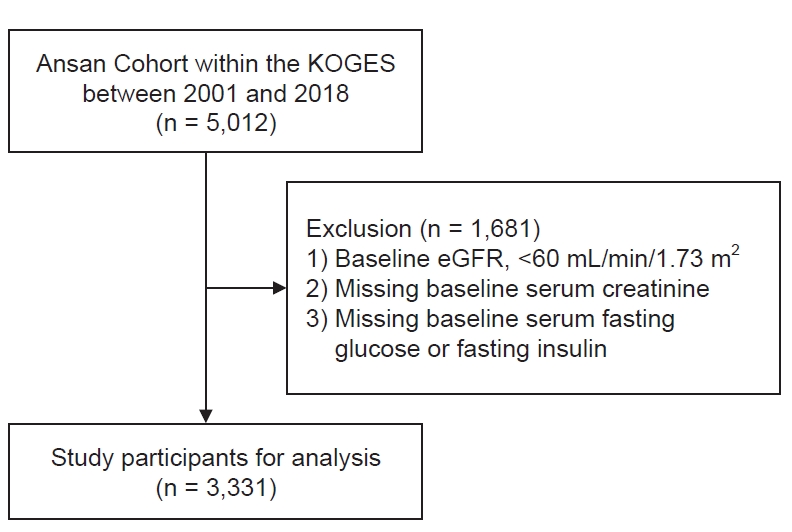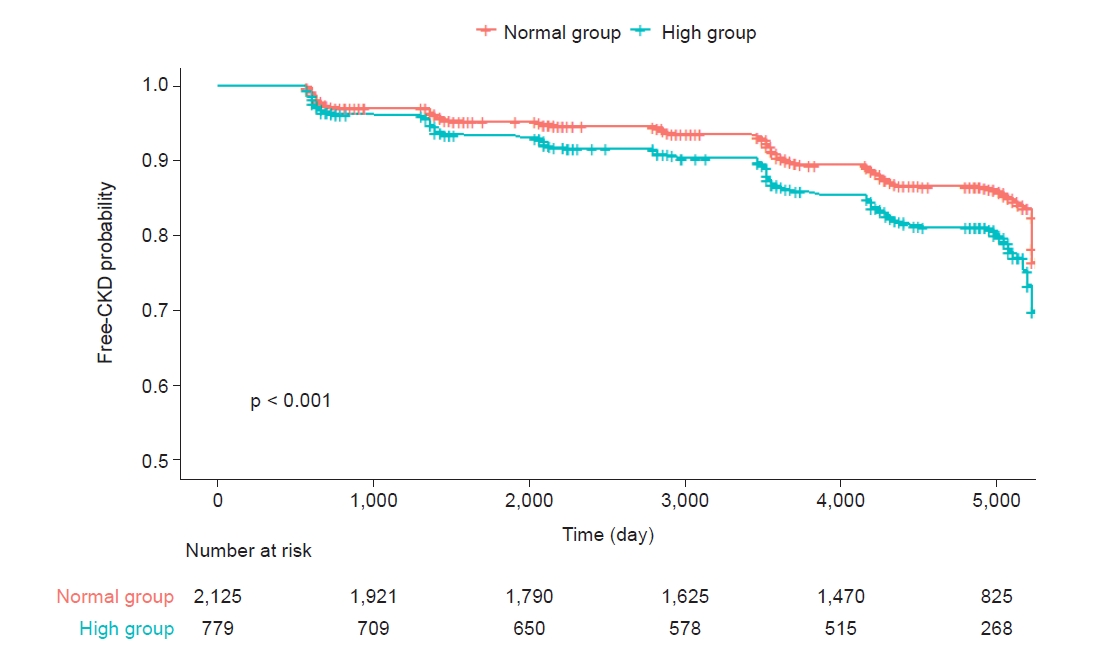| Kidney Res Clin Pract > Epub ahead of print |
Abstract
Background
Methods
Results
Notes
Funding
This research was supported by a grant from Chonnam National University Hospital Biomedical Research Institute (No. BCRI22040) and the National Research Foundation of Korea (NRF) grant funded by the Korea government (MSIT) (2019R1A2C1003971&RS-2023-00217317).
Figure 1.
Flow diagram of the study population.

Figure 2.
Restricted cubic spline curve of hazard ratio of HOMA-IR level for incident chronic kidney disease probability.

Figure 3.
The Kaplan-Meier free-CKD probability curve with the log-rank test between high HOMA-IR group and incident CKD.

Figure 4.
Cox regression analysis of HOMA-IR for incident chronic kidney disease in various subgroups.

Table 1.
| Characteristic |
Total population (n = 3,331) |
p-value | |
|---|---|---|---|
| Normal group | High groupa | ||
| No. of patients | 2,421 | 910 | |
| Age (yr) | 48.8 ± 7.6 | 49.0 ± 7.8 | 0.48 |
| Male sex | 1,179 (48.7) | 491 (54.0) | 0.008 |
| Education | 0.26 | ||
| No education or elementary school graduate | 376 (15.6) | 155 (17.1) | |
| Middle school graduate | 542 (22.4) | 177 (19.5) | |
| High school graduate | 1,028 (42.5) | 380 (41.9) | |
| More than college graduate | 471 (19.5) | 195 (21.6) | |
| Alcohol drinking status | 0.12 | ||
| Never | 1,084 (44.9) | 374 (41.2) | |
| Ex-drinker | 121 (5.0) | 55 (6.1) | |
| Drinker | 1,211 (50.1) | 479 (52.8) | |
| Smoking status | 0.045 | ||
| Never | 1,431 (59.5) | 495 (54.5) | |
| Ex-smoker | 423 (17.6) | 180 (19.8) | |
| Current smoker | 553 (23.0) | 233 (25.7) | |
| Hypertension | 229 (9.5) | 160 (17.6) | <0.001 |
| Systolic BP (mmHg) | 114.9 ± 17.3 | 119.6 ± 17.1 | <0.001 |
| Diastolic BP (mmHg) | 77.8 ± 11.8 | 81.0 ± 11.6 | <0.001 |
| BUN (mg/dL) | 13.6 ± 3.5 | 14.0 ± 3.5 | 0.003 |
| Creatinine (mg/dL) | 0.8 ± 0.2 | 0.9 ± 0.2 | <0.001 |
| eGFR (mL/min/1.73 m2) | 94.3 ± 14.8 | 92.3 ± 15.3 | 0.001 |
| UPCR (g/gCr) | 0.1 ± 0.3 | 0.1 ± 0.2 | 0.99 |
| Hemoglobin (g/dL) | 13.6 ± 1.6 | 13.9 ± 1.5 | <0.001 |
| Serum albumin (g/dL) | 4.6 ± 0.3 | 4.6 ± 0.3 | 0.27 |
| Na (mmol/L) | 142.8 ± 2.2 | 142.8 ± 2.2 | 0.78 |
| K (mmol/L) | 4.5 ± 0.5 | 4.4 ± 0.4 | <0.001 |
| Total cholesterol (mg/dL) | 193.9 ± 34.6 | 202.1 ± 38.2 | <0.001 |
| HDL cholesterol (mg/dL) | 45.5 ± 10.1 | 42.7 ± 9.1 | <0.001 |
| LDL cholesterol (mg/dL) | 118.5 ± 32.5 | 121.0 ± 35.0 | 0.07 |
| Triglyceride (mg/dL) | 149.0 ± 96.8 | 192.0 ± 127.2 | <0.001 |
| Body mass index (kg/m2) | 24.2 ± 2.8 | 26.0 ± 3.0 | <0.001 |
| HOMA-IR | 1.2 ± 0.4 | 2.7 ± 1.2 | <0.001 |
| QUICKI | 3.7 ± 0.2 | 3.3 ± 0.1 | <0.001 |
| HOMA-AD | 3.9 ± 2.4 | 5.4 ± 2.7 | <0.001 |
| LAR | 1.7 ± 1.8 | 2.3 ± 1.9 | <0.001 |
Data are expresses as number only, mean ± standard deviation, or number (%).
BUN, blood urea nitrogen; BP, blood pressure; eGFR, estimated glomerular filtration rate; HDL, high-density lipoprotein; HOMA-AD, homeostasis model assessment-adiponectin; HOMA-IR, homeostasis model assessment-insulin resistance; K, potassium; LAR, leptin-adiponectin ratio; LDL, low-density lipoprotein; Na, sodium; QUICKI, quantitative insulin sensitivity check index; UPCR, urine protein-creatinine ratio.
Table 2.
| Variable |
Unadjusted |
Adjusted |
||||||
|---|---|---|---|---|---|---|---|---|
|
Model 1a |
Model 2b |
Model 3c |
||||||
| HR (95% CI) | p-value | HR (95% CI) | p-value | HR (95% CI) | p-value | HR (95% CI) | p-value | |
| HOMA-IR | 1.22 (1.13–1.33) | <0.001 | 1.19 (1.12–1.27) | <0.001 | 1.16 (1.08–1.25) | <0.001 | 1.13 (1.05–1.22) | 0.001 |
| Normal group | 1 (Reference) | - | 1 (Reference) | - | 1 (Reference) | - | 1 (Reference) | - |
| High group | 1.49 (1.21–1.83) | <0.001 | 1.66 (1.35–2.03) | <0.001 | 1.44 (1.17–1.79) | <0.001 | 1.40 (1.13–1.74) | 0.002 |
Table 3.
| Variable |
Unadjusted |
Adjusted |
||||||
|---|---|---|---|---|---|---|---|---|
|
Model 1a |
Model 2b |
Model 3c |
||||||
| HR (95% CI) | p-value | HR (95% CI) | p-value | HR (95% CI) | p-value | HR (95% CI) | p-value | |
| HOMA-IR | 1.22 (1.13–1.33) | <0.001 | 1.19 (1.12–1.27) | <0.001 | 1.16 (1.08–1.25) | <0.001 | 1.13 (1.05–1.22) | 0.001 |
| QUICKI*10 | 0.50 (0.33–0.74) | <0.001 | 0.46 (0.31–0.67) | <0.001 | 0.58 (0.39–0.86) | 0.006 | 0.62 (0.41–0.92) | 0.02 |
| HOMA-AD | 1.05 (1.00–1.11) | 0.031 | 1.06 (1.01–1.11) | 0.02 | 1.03 (0.97–1.08) | 0.357 | 1.03 (0.98–1.08) | 0.29 |
| LAR | 1.16 (1.04–1.29) | 0.007 | 1.29 (1.14–1.47) | <0.001 | 1.21 (1.05–1.40) | 0.008 | 1.23 (1.06–1.42) | 0.006 |
References
-
METRICS

-
- 0 Crossref
- 0 Scopus
- 434 View
- 24 Download
- ORCID iDs
-
Su Hyun Song

https://orcid.org/0000-0003-3510-8655Young Jin Goo

https://orcid.org/0000-0002-5747-1212Tae Ryom Oh

https://orcid.org/0000-0002-3713-0939Sang Heon Suh

https://orcid.org/0000-0003-3076-3466Hong Sang Choi

https://orcid.org/0000-0001-8191-4071Chang Seong Kim

https://orcid.org/0000-0001-8753-7641Seong Kwon Ma

https://orcid.org/0000-0002-5758-8189Soo Wan Kim

https://orcid.org/0000-0002-3540-9004Eun Hui Bae

https://orcid.org/0000-0003-1727-2822 - Related articles



 PDF Links
PDF Links PubReader
PubReader ePub Link
ePub Link Full text via DOI
Full text via DOI Download Citation
Download Citation Print
Print















